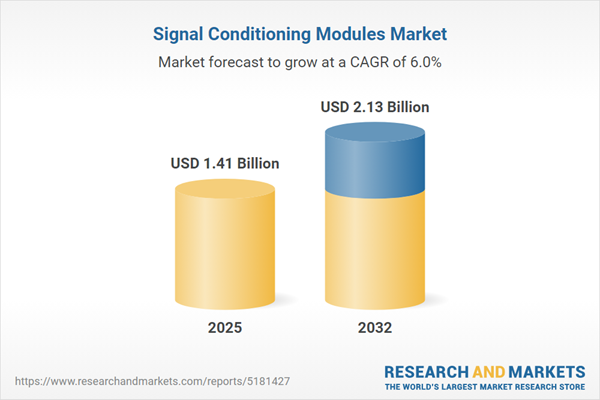Speak directly to the analyst to clarify any post sales queries you may have.
Signal conditioning modules are essential in connecting physical sensor data to digital systems, ensuring the accuracy and reliability of measurements across multiple industries. The signal conditioning modules market is evolving rapidly, with demand accelerating in sectors focused on operational efficiency, safety, and real-time performance.
Market Snapshot: Signal Conditioning Modules Market
The global signal conditioning modules market grew from USD 1.33 billion in 2024 to USD 1.41 billion in 2025. Continued expansion at a CAGR of 6.03% is anticipated, with the market forecast to reach USD 2.13 billion by 2032. Robust demand stems from the proliferation of sensors and the increasing importance of high-fidelity data in smart applications.
Scope & Segmentation
This report offers comprehensive insight into the diverse landscape of signal conditioning modules by analyzing product types, signal varieties, end-use sectors, technology, distribution channels, and global regions.
- Product Types: Instrumentation amplifiers, operational amplifiers, current-to-voltage converters, thermocouple converters, voltage-to-current converters, band-pass filters, high-pass filters, low-pass filters, optical isolators, transformer isolators.
- Signal Types: Current, pressure, temperature, voltage.
- End Users: Energy & power, healthcare, industrial automation, oil & gas.
- Technologies: Analog, digital.
- Channels: Direct sales, distributors, online sales.
- Regions: Americas (North America, Latin America), Europe Middle East & Africa (Europe, Middle East, Africa), Asia-Pacific (including China, India, Japan, Australia, South Korea, Indonesia, Thailand, Malaysia, Singapore, Taiwan).
Detailed company analysis is included for key manufacturers such as Analog Devices, Texas Instruments, Siemens, ABB, Honeywell, Schneider Electric, Emerson, TE Connectivity, National Instruments, and Eaton.
Key Takeaways for Senior Decision Makers
- Signal conditioning modules are at the core of digital transformation, with their reliability and versatility critical for industries focused on minimizing operational risks and maximizing productivity.
- Technological innovation has shifted modules from passive signal processors to intelligent system enablers, integrating diagnostics, remote configuration, and advanced analytics aligned with real-time monitoring.
- Collaborative product development, especially between module builders and sensor manufacturers, is streamlining integration, supporting faster deployment, and enabling modular system architectures.
- Regional variations shape adoption—Americas focus on legacy compatibility and smart grid resilience, EMEA on sustainability and compliance, and Asia-Pacific on rapid industrial digitalization and localized manufacturing.
- Competitive strategies increasingly revolve around delivering customization, secure connectivity, and value-added services, driving deeper customer engagement and long-term support models.
Tariff Impact on Market Strategies
The introduction of US tariffs in 2025 on key electronic components has reshaped procurement and sourcing strategies throughout the signal conditioning modules value chain. Manufacturers have accelerated investments in regional supplier relationships, nearshoring, and the adoption of alternative materials. These changes aim to safeguard margins, improve supply chain resilience, and maintain product continuity despite shifting cost structures.
Signal Conditioning Modules Market: Methodology & Data Sources
This report is based on a layered research approach, incorporating primary interviews with senior executives, engineers, and channel partners, complemented by thorough analysis of secondary sources such as white papers, patents, and technical journals. Triangulation and expert validation ensured robust, actionable insights throughout the research process.
Why This Report Matters
- Enables strategic planning by outlining regional and sector-specific growth drivers, technology preferences, and supply chain considerations.
- Provides actionable intelligence for developing differentiated products, mitigating supply risks, and enhancing channel strategies across evolving market landscapes.
Senior leaders gain a clear view of opportunities and operational challenges, positioning organizations to anticipate market shifts and remain competitive as digitalization accelerates.
Conclusion
The signal conditioning modules market is undergoing significant transformation, fueled by technological progress, strategic collaboration, and shifting sourcing models. Leadership lies in agility, robust supply strategies, and investment in innovation to deliver performance aligned with evolving industry needs.
Additional Product Information:
- Purchase of this report includes 1 year online access with quarterly updates.
- This report can be updated on request. Please contact our Customer Experience team using the Ask a Question widget on our website.
Table of Contents
3. Executive Summary
4. Market Overview
7. Cumulative Impact of Artificial Intelligence 2025
List of Figures
Samples

LOADING...
Companies Mentioned
The key companies profiled in this Signal Conditioning Modules market report include:- Analog Devices, Inc.
- Texas Instruments Incorporated
- Siemens Aktiengesellschaft
- ABB Ltd.
- Honeywell International Inc.
- Schneider Electric SE
- Emerson Electric Co.
- TE Connectivity Ltd.
- National Instruments Corporation
- Eaton Corporation plc
Table Information
| Report Attribute | Details |
|---|---|
| No. of Pages | 194 |
| Published | October 2025 |
| Forecast Period | 2025 - 2032 |
| Estimated Market Value ( USD | $ 1.41 Billion |
| Forecasted Market Value ( USD | $ 2.13 Billion |
| Compound Annual Growth Rate | 6.0% |
| Regions Covered | Global |
| No. of Companies Mentioned | 11 |









